- Messages
- 92
- Reaction score
- 0
- Points
- 26
hope that you enjoy the information found on this thread.
All material on this site is for personal use only.
Copyright 2007-2009 Millermeade Farm's Critter Connection. All Rights Reserved.
Physical Characteristics
Size
The average hedgehog weighs approximately ½ to 1-¼ pounds and most are the size of a softball or slightly larger when they are rolled into a ball.
Some adult hedgehogs have a slightly larger build and can weigh up to 2 pounds (the size of a small guinea pig) without being fat.
Most hedgehogs are 6-8 inches in length, but it is hard to accurately and consistently measure a hedgehog because their body changes shape when it is balled up, relaxed, sitting or moving.
Spines
The most unique and obvious physical characteristic of hedgehogs is their spines.
The weight of the spines accounts for approximately 35% of the hedgehog’s weight. (Miller)
Technically speaking, hedgehogs have spines and not quills, but their unique hair is often referred to as quills.
The hedgehog’s spines have solid shafts, whereas quills are hollow like a feather. Also, the hedgehog does NOT release its spines as a form of defense, as a porcupine does its quills.
Another contrast between a porcupine’s quills is a hedgehog’s spines do NOT have barbs on the end that can stick in your skin like a porcupine’s quills.
Hedgehogs do use their spines as their main line of defense by erecting them so they criss-cross and point in different directions protecting the skin and body.
Hedgehogs have an orbicularis muscle that it contracts like a drawstring when it rolls up into a ball.
The hedgehog hides its head and legs by creating a ball and using its spines as protection.
Hedgehogs can puff of pop, and if you are poked by an individual spine it can be painful.
Proper handling techniques allow the hedgehog to become relaxed and handled comfortably.
Its spines will lay flat toward the tail when relaxed, and the spines will feel relatively smooth when petted from front to back.
Forehead Furrow
There is a natural part in the spines on the forehead of the hedgehog.
A hedgehog can raise its forehead spines when it is nervous or mildly irritated. The furrow provides space for the raised spines so they point forward instead of criss-crossing when the skin is pulled down over the eyes.
Teeth
Hedgehogs have 36-44 teeth in a long, pointy snout.
The first pair of incisors is slightly larger than the rest, but they are certainly not as dramatically different in size from their other teeth as a rodent’s front teeth.
Hedgehog incisors do not continuously grow, as do rodent incisors, and so they do not have an innate need to chew or gnaw on things to wear down their teeth.
The baby teeth are shed early and replaced by rooted adult teeth.
Poor diet can cause tooth decay and gum disease.
Feet
Hedgehogs have 4 toes on the rear feet and 5 toes on the front feet in the Atelerix species.
The nails on the front feet may need trimmed more frequently than the rear feet to prevent them from curling into the foot and damaging the footpad.
Hedgehogs’ feet and toes are made for walking and running.
They do not have opposable thumbs or fingers for grasping or vertical climbing.
Tails
Both sexes have short, stubby tails that are usually hidden under their quills.
The tail can be confused with a penis because the tail curves toward the head when the hedgehog is placed on its back. The male’s penile sheath and hidden penis are located mid-abdominally.
Fur
Hedgehogs have soft, white fur on their face and bellies.
They typically keep their fur clean and neat and a healthy hedgehog should have no mats or caking of its fur.
Chin Mole
This small bump under the chin is harmless and normal.
It is often referred to as a “cutie mark.”
Colors
The Atelerix species tends to have whitish or light colored faces, whereas the Algerian hedgehog has a darker face. Most hedgehogs pets today are a hybrid of the two species and the very dark Algerian face masks are fairly rare.
Hedgehog spines or quills can range in color from an almost black band to a very pale peach color in the banding.
The spines may be banded or solid white.
Hedgehogs may actually change color variations as they mature and get older. The best age to determine color is approximately one year.
The International Hedgehog Association and the Hedgehog Central Web site acknowledge more than 90 different colors of hedgehogs. These colors include various quill colorations, as well as their snowflake and white varieties.
Quill, skin, face, nose, and leg coloration all come into play when determining the hedgehog’s true color.
Many hedgehog enthusiasts simplify the colors by placing hedgehogs in a few many categories such as standard (black to brown variations), cinnacot (tan or light brown variations), black eyed whites (90% or more white quills), albinos, snowflakes (10-89% white quills), and pintos (any color with patches of white quills).
Odor
Hedgehogs do not have a scent gland like ferrets and, therefore, do not have a particularly strong body odor.
Hedgehog urine does not contain large amounts of ammonia like a rabbit or a guinea pig.
Male hedgehog urine is not stronger than female like male rats, mice, or cats.
Hedgehogs do defecate and their feces do stink. What a hedgehog eats affects the feces odor. Wet foods and certain brands of foods produce more of an odor than other foods.
There are products available (we sell Elimina) that are sprayed on the food or added to the drinking water that help combat odor internally.
Cage cleaning and bedding choices are important parts of keeping hedgehog smell to a minimum.
Human Allergic Reactions
There is always a possibility that someone can be allergic to hedgehogs.
Dander is a common, animal-related allergy for many people. Cat dander is produced when saliva is deposited on the fur during the self-cleaning process. The dander turns into a fine dust. Hedgehogs are typically considered dander free, but they do self anoint, which could be irritating to some people.
Many people allergic to small animals are actually allergic to the bedding. Most bedding is dusty, but hedgehogs can be housed on a variety of beddings that may help to eliminate a dust irritation.
It is always a good idea to visit a hedgehog prior to purchase if you suspect you are allergic to other animals.
It is possible to have red prickle marks on your hands after handling a hedgehog. I, personally, have gotten these prickle marks several times throughout the years, but it certainly isn’t a consistent phenomenon.
One long-time hedgehog owner shared with me her hypothesis that when hedgehogs are extremely scared, they can emit a toxin that causes a reaction. While this certainly would explain my experiences, I have been unable to find further documentation on the subject, and it is not a topic that regularly comes up with my customers.
Another acquaintance told me they had a hedgehog for quite some time when they suddenly developed sensitivity to their pet.
No animal is 100% allergy-free!
Senses
Hedgehogs, like all other animals, use their senses to gather information from their environment.
One must take into consideration how hedgehogs use their senses when handling them and during the socialization and bonding processes.
Sight
Hedgehogs have small, beady eyes and a poor sense of sight. This is probably due in part to their burrowing nature.
Compared to humans, and even dogs and cats, hedgehogs have limited binocular vision.
They have a hard time with depth perception and will often fall from dangerous heights because they simply cannot tell how far they are from the ground.
Other hedgehog senses are much stronger and overcompensate for this weakness.
Hearing
Hedgehogs have large ears and have an excellent sense of hearing.
Unfamiliar sounds or loud noises can cause hedgehogs to react in defense by huffing and ducking their head in defense.
Hedgehogs can become accustomed to a busy household but it may take some time to get used to new surroundings.
Smell
Hedgehogs have an excellent sense of smell that is very useful to them in search of food and detecting danger.
Their nose is warm and moist and a curious hedgehog will have their snout in the air sniffing in order to gather information from its environment. At the slightest threat of danger (usually detected by noise or movement) they will duck their head for protection.
Motion Detection
Hedgehogs are very good at detecting motion around them, even when they are rolled into a ball or cannot see.
Hedgehogs will often perceive movement as danger unless they are completely relaxed with their surroundings.
A sleeping hedgehog (or a hedgehog trying to go to sleep) may display their annoyance of movement around them even if they know the cause of the movement.
For instance, if you are in the dark you can sense movement even if you cannot see what is moving. A good example is a haunted house – you are naturally afraid when something moves close to you, until you can distinguish between the unknown and a friend.
They will raise their quills when they sense movement to protect themselves. They are naturally defensive until they are convinced they are safe.
It is human nature to want to reach out and touch a hedgehog when it is sleeping or curled into a ball in its cage. What we might consider touching, a hedgie considers a poke, and it will almost always raise its quills with a huff and a puff resulting in a prick to the poking finger.
Proper handling can help prevent the automatic fear when being picked up.
Emotion Detection
Hedgehogs, like other animals, are able to sense the fear, nervousness, or confidence of the humans handling them.
Hedgehogs have a tendency to act more nervous if they sense you are nervous and will relax more quickly if you are calm.
Vocalizations
Hedgehogs have a wide range of sounds that they use to communicate.
You must listen carefully and observe the hedgehog’s behavior to clearly understand what your pet is trying to communicate.
Different people can describe each noise that a hedgehog makes in different terms.
Some sounds require little or no attention on your part such as the squeaking or chirping of new babies. Other sounds such as clicking or popping should be a clear sign to you that your hedgehog is in defense mode and you need to change how you are handling your pet.
Chirping/Squeaking- this sound is often the first indication of new babies.
Grunting - may be a sign of contentment.
Purring or Whistling – sign of contentment. You know your hedgehog is truly enjoying your company when you hear this sound.
Singing- strange sounds that are part of the mating ritual.
Huffing, Puffing, Sneezing - a sign of irritation, annoyance, or uncertainty. Hedgehogs might huff and puff, but they will not blow your house down! They are simply trying to tell you to back off and give them some space.
Clicking or Popping - these sounds are the aggressive/defensive sounds that are made when a hedgehog is trying to defend itself.
Sneezing, Wheezing, Snuffling – certainly these sounds can be a sign of illness but some hedgehogs are simply trying to have a hedgehog “conversation” with you or are simply checking things out.
Squealing
You may hear this sound when a fight is about to occur between two hedgehogs.
It is a good idea to keep a close eye on the hedgies because injuries can quickly occur during fights.
Screaming
This sound is something that you never want to hear. It is a sound of pain or extreme fear.
Fighting or accidental injury can be causes for this sound.
Hedgehogs have been known to make this noise in their sleep with no apparent cause as if they are having a hedgie nightmare.
Longevity
Hedgehogs typically live two to three years in the wild. The most common cause of death in the wild is due to predation rather than age.
Hedgehogs can live up to 10 years in captivity, but those hedgehogs are few and far between. A 10-year-old hedgehog would be similar to a 104-year-old grandma.
A 5-year-old hedgehog is about 76 in people years, so if your hedgehog lives 5-7 years it has lived a full life but five years is longer than the national average.
According to the article “Mortality and Longevity, Update! Boys vs. Girls” found in the September to December International Hedgehog Association Newsletter, “There is no statistical difference in life expectancy between male and female hedgehogs. The average Hedgehog Lifespan is 38.5 months as of July 27, 2005.” (Graesser)
Several things to consider when looking at longevity are diet, type of bedding, veterinary care, environmental stressors, and genetics.
The number one cause of hedgehog death is various forms of cancer.
We hope that your hedgehog lives to a ripe old age but, unfortunately, not all pets live as long as others because of the previously mentioned factors. We appreciate feedback from our customers so that we trace bloodlines. It is important for us to know the parents of your hedgehog (from your receipt), as well as the cause of death of your pet if known.
Signs of Good Health
Check its eyes to make sure they are bold, clear, round, and bright. The eyes should be wide open. The eyes should not be watery or sunken, dull, or have any discharge.
The hedgehog’s nose should be moist and clean. It should not be dry, bubbly, or running.
Your hedgehog’s ears should be clean with no drainage, crustiness, or flaking on the outer part of the ear.
Check the skin to make sure there are no abrasions, lumps, bumps, excessive dryness, bare patches, or signs of mites.
The underbelly fur should not be matted.
The hedgehog’s body should be filled out through the back and sides.
Some hedgehogs have a streamlined appearance, but their skin should not be loose and they should be filled out below the ribs.
Other hedgehogs are plumper but they should not be so fat that they cannot easily roll into a ball.
Breathing should be regular with no wheezing or signs of stress. Do not confuse the normal hedgehog huffing for the rattle of a respiratory illness.
Notice the amount of food and water consumption from the previous night and has the hedgehog gained or lost a significant amount of weight.
The hedgehog’s bowl movements should be similar in color to the hedgehog’s food. Green droppings or diarrhea are signs of illness and stress.
Your hedgehog should move freely without limping, wobbling, or dragging its feet. A hedgehog’s normal gait will create a “pitter-patter” sound.
I encourage NOT buying an animal as a “rescue” to remove it from terrible conditions either from a breeder or a pet store. Purchasing the animal may improve that particular animal’s condition, but it will do nothing to prevent future animals from being housed or maintained in similar situations. Instead, kindly and respectfully point out the problem and try to educate the person or store about proper hedgehog care. Some instances of neglect are not from intent but from lack of information. Should the situation not improve it may be necessary to notify the proper authorities. Hedgehog sales are governed by the USDA, which is obligated to investigate all complaints.
Basic Breeding Information
Baby hedgehogs are called hoglets.
Hedgehogs can produce litter sizes ranging from 1-9, with the average litter size being 3-4.
The gestation or the amount of time from conception time until birth is typically 33-35 days.
The average recommended breeding age is six months.



All material on this site is for personal use only.
Copyright 2007-2009 Millermeade Farm's Critter Connection. All Rights Reserved.
Physical Characteristics
Size
The average hedgehog weighs approximately ½ to 1-¼ pounds and most are the size of a softball or slightly larger when they are rolled into a ball.
Some adult hedgehogs have a slightly larger build and can weigh up to 2 pounds (the size of a small guinea pig) without being fat.
Most hedgehogs are 6-8 inches in length, but it is hard to accurately and consistently measure a hedgehog because their body changes shape when it is balled up, relaxed, sitting or moving.
Spines
The most unique and obvious physical characteristic of hedgehogs is their spines.
The weight of the spines accounts for approximately 35% of the hedgehog’s weight. (Miller)
Technically speaking, hedgehogs have spines and not quills, but their unique hair is often referred to as quills.
The hedgehog’s spines have solid shafts, whereas quills are hollow like a feather. Also, the hedgehog does NOT release its spines as a form of defense, as a porcupine does its quills.
Another contrast between a porcupine’s quills is a hedgehog’s spines do NOT have barbs on the end that can stick in your skin like a porcupine’s quills.
Hedgehogs do use their spines as their main line of defense by erecting them so they criss-cross and point in different directions protecting the skin and body.
Hedgehogs have an orbicularis muscle that it contracts like a drawstring when it rolls up into a ball.
The hedgehog hides its head and legs by creating a ball and using its spines as protection.
Hedgehogs can puff of pop, and if you are poked by an individual spine it can be painful.
Proper handling techniques allow the hedgehog to become relaxed and handled comfortably.
Its spines will lay flat toward the tail when relaxed, and the spines will feel relatively smooth when petted from front to back.
Forehead Furrow
There is a natural part in the spines on the forehead of the hedgehog.
A hedgehog can raise its forehead spines when it is nervous or mildly irritated. The furrow provides space for the raised spines so they point forward instead of criss-crossing when the skin is pulled down over the eyes.
Teeth
Hedgehogs have 36-44 teeth in a long, pointy snout.
The first pair of incisors is slightly larger than the rest, but they are certainly not as dramatically different in size from their other teeth as a rodent’s front teeth.
Hedgehog incisors do not continuously grow, as do rodent incisors, and so they do not have an innate need to chew or gnaw on things to wear down their teeth.
The baby teeth are shed early and replaced by rooted adult teeth.
Poor diet can cause tooth decay and gum disease.
Feet
Hedgehogs have 4 toes on the rear feet and 5 toes on the front feet in the Atelerix species.
The nails on the front feet may need trimmed more frequently than the rear feet to prevent them from curling into the foot and damaging the footpad.
Hedgehogs’ feet and toes are made for walking and running.
They do not have opposable thumbs or fingers for grasping or vertical climbing.
Tails
Both sexes have short, stubby tails that are usually hidden under their quills.
The tail can be confused with a penis because the tail curves toward the head when the hedgehog is placed on its back. The male’s penile sheath and hidden penis are located mid-abdominally.
Fur
Hedgehogs have soft, white fur on their face and bellies.
They typically keep their fur clean and neat and a healthy hedgehog should have no mats or caking of its fur.
Chin Mole
This small bump under the chin is harmless and normal.
It is often referred to as a “cutie mark.”
Colors
The Atelerix species tends to have whitish or light colored faces, whereas the Algerian hedgehog has a darker face. Most hedgehogs pets today are a hybrid of the two species and the very dark Algerian face masks are fairly rare.
Hedgehog spines or quills can range in color from an almost black band to a very pale peach color in the banding.
The spines may be banded or solid white.
Hedgehogs may actually change color variations as they mature and get older. The best age to determine color is approximately one year.
The International Hedgehog Association and the Hedgehog Central Web site acknowledge more than 90 different colors of hedgehogs. These colors include various quill colorations, as well as their snowflake and white varieties.
Quill, skin, face, nose, and leg coloration all come into play when determining the hedgehog’s true color.
Many hedgehog enthusiasts simplify the colors by placing hedgehogs in a few many categories such as standard (black to brown variations), cinnacot (tan or light brown variations), black eyed whites (90% or more white quills), albinos, snowflakes (10-89% white quills), and pintos (any color with patches of white quills).
Odor
Hedgehogs do not have a scent gland like ferrets and, therefore, do not have a particularly strong body odor.
Hedgehog urine does not contain large amounts of ammonia like a rabbit or a guinea pig.
Male hedgehog urine is not stronger than female like male rats, mice, or cats.
Hedgehogs do defecate and their feces do stink. What a hedgehog eats affects the feces odor. Wet foods and certain brands of foods produce more of an odor than other foods.
There are products available (we sell Elimina) that are sprayed on the food or added to the drinking water that help combat odor internally.
Cage cleaning and bedding choices are important parts of keeping hedgehog smell to a minimum.
Human Allergic Reactions
There is always a possibility that someone can be allergic to hedgehogs.
Dander is a common, animal-related allergy for many people. Cat dander is produced when saliva is deposited on the fur during the self-cleaning process. The dander turns into a fine dust. Hedgehogs are typically considered dander free, but they do self anoint, which could be irritating to some people.
Many people allergic to small animals are actually allergic to the bedding. Most bedding is dusty, but hedgehogs can be housed on a variety of beddings that may help to eliminate a dust irritation.
It is always a good idea to visit a hedgehog prior to purchase if you suspect you are allergic to other animals.
It is possible to have red prickle marks on your hands after handling a hedgehog. I, personally, have gotten these prickle marks several times throughout the years, but it certainly isn’t a consistent phenomenon.
One long-time hedgehog owner shared with me her hypothesis that when hedgehogs are extremely scared, they can emit a toxin that causes a reaction. While this certainly would explain my experiences, I have been unable to find further documentation on the subject, and it is not a topic that regularly comes up with my customers.
Another acquaintance told me they had a hedgehog for quite some time when they suddenly developed sensitivity to their pet.
No animal is 100% allergy-free!
Senses
Hedgehogs, like all other animals, use their senses to gather information from their environment.
One must take into consideration how hedgehogs use their senses when handling them and during the socialization and bonding processes.
Sight
Hedgehogs have small, beady eyes and a poor sense of sight. This is probably due in part to their burrowing nature.
Compared to humans, and even dogs and cats, hedgehogs have limited binocular vision.
They have a hard time with depth perception and will often fall from dangerous heights because they simply cannot tell how far they are from the ground.
Other hedgehog senses are much stronger and overcompensate for this weakness.
Hearing
Hedgehogs have large ears and have an excellent sense of hearing.
Unfamiliar sounds or loud noises can cause hedgehogs to react in defense by huffing and ducking their head in defense.
Hedgehogs can become accustomed to a busy household but it may take some time to get used to new surroundings.
Smell
Hedgehogs have an excellent sense of smell that is very useful to them in search of food and detecting danger.
Their nose is warm and moist and a curious hedgehog will have their snout in the air sniffing in order to gather information from its environment. At the slightest threat of danger (usually detected by noise or movement) they will duck their head for protection.
Motion Detection
Hedgehogs are very good at detecting motion around them, even when they are rolled into a ball or cannot see.
Hedgehogs will often perceive movement as danger unless they are completely relaxed with their surroundings.
A sleeping hedgehog (or a hedgehog trying to go to sleep) may display their annoyance of movement around them even if they know the cause of the movement.
For instance, if you are in the dark you can sense movement even if you cannot see what is moving. A good example is a haunted house – you are naturally afraid when something moves close to you, until you can distinguish between the unknown and a friend.
They will raise their quills when they sense movement to protect themselves. They are naturally defensive until they are convinced they are safe.
It is human nature to want to reach out and touch a hedgehog when it is sleeping or curled into a ball in its cage. What we might consider touching, a hedgie considers a poke, and it will almost always raise its quills with a huff and a puff resulting in a prick to the poking finger.
Proper handling can help prevent the automatic fear when being picked up.
Emotion Detection
Hedgehogs, like other animals, are able to sense the fear, nervousness, or confidence of the humans handling them.
Hedgehogs have a tendency to act more nervous if they sense you are nervous and will relax more quickly if you are calm.
Vocalizations
Hedgehogs have a wide range of sounds that they use to communicate.
You must listen carefully and observe the hedgehog’s behavior to clearly understand what your pet is trying to communicate.
Different people can describe each noise that a hedgehog makes in different terms.
Some sounds require little or no attention on your part such as the squeaking or chirping of new babies. Other sounds such as clicking or popping should be a clear sign to you that your hedgehog is in defense mode and you need to change how you are handling your pet.
Chirping/Squeaking- this sound is often the first indication of new babies.
Grunting - may be a sign of contentment.
Purring or Whistling – sign of contentment. You know your hedgehog is truly enjoying your company when you hear this sound.
Singing- strange sounds that are part of the mating ritual.
Huffing, Puffing, Sneezing - a sign of irritation, annoyance, or uncertainty. Hedgehogs might huff and puff, but they will not blow your house down! They are simply trying to tell you to back off and give them some space.
Clicking or Popping - these sounds are the aggressive/defensive sounds that are made when a hedgehog is trying to defend itself.
Sneezing, Wheezing, Snuffling – certainly these sounds can be a sign of illness but some hedgehogs are simply trying to have a hedgehog “conversation” with you or are simply checking things out.
Squealing
You may hear this sound when a fight is about to occur between two hedgehogs.
It is a good idea to keep a close eye on the hedgies because injuries can quickly occur during fights.
Screaming
This sound is something that you never want to hear. It is a sound of pain or extreme fear.
Fighting or accidental injury can be causes for this sound.
Hedgehogs have been known to make this noise in their sleep with no apparent cause as if they are having a hedgie nightmare.
Longevity
Hedgehogs typically live two to three years in the wild. The most common cause of death in the wild is due to predation rather than age.
Hedgehogs can live up to 10 years in captivity, but those hedgehogs are few and far between. A 10-year-old hedgehog would be similar to a 104-year-old grandma.
A 5-year-old hedgehog is about 76 in people years, so if your hedgehog lives 5-7 years it has lived a full life but five years is longer than the national average.
According to the article “Mortality and Longevity, Update! Boys vs. Girls” found in the September to December International Hedgehog Association Newsletter, “There is no statistical difference in life expectancy between male and female hedgehogs. The average Hedgehog Lifespan is 38.5 months as of July 27, 2005.” (Graesser)
Several things to consider when looking at longevity are diet, type of bedding, veterinary care, environmental stressors, and genetics.
The number one cause of hedgehog death is various forms of cancer.
We hope that your hedgehog lives to a ripe old age but, unfortunately, not all pets live as long as others because of the previously mentioned factors. We appreciate feedback from our customers so that we trace bloodlines. It is important for us to know the parents of your hedgehog (from your receipt), as well as the cause of death of your pet if known.
Signs of Good Health
Check its eyes to make sure they are bold, clear, round, and bright. The eyes should be wide open. The eyes should not be watery or sunken, dull, or have any discharge.
The hedgehog’s nose should be moist and clean. It should not be dry, bubbly, or running.
Your hedgehog’s ears should be clean with no drainage, crustiness, or flaking on the outer part of the ear.
Check the skin to make sure there are no abrasions, lumps, bumps, excessive dryness, bare patches, or signs of mites.
The underbelly fur should not be matted.
The hedgehog’s body should be filled out through the back and sides.
Some hedgehogs have a streamlined appearance, but their skin should not be loose and they should be filled out below the ribs.
Other hedgehogs are plumper but they should not be so fat that they cannot easily roll into a ball.
Breathing should be regular with no wheezing or signs of stress. Do not confuse the normal hedgehog huffing for the rattle of a respiratory illness.
Notice the amount of food and water consumption from the previous night and has the hedgehog gained or lost a significant amount of weight.
The hedgehog’s bowl movements should be similar in color to the hedgehog’s food. Green droppings or diarrhea are signs of illness and stress.
Your hedgehog should move freely without limping, wobbling, or dragging its feet. A hedgehog’s normal gait will create a “pitter-patter” sound.
I encourage NOT buying an animal as a “rescue” to remove it from terrible conditions either from a breeder or a pet store. Purchasing the animal may improve that particular animal’s condition, but it will do nothing to prevent future animals from being housed or maintained in similar situations. Instead, kindly and respectfully point out the problem and try to educate the person or store about proper hedgehog care. Some instances of neglect are not from intent but from lack of information. Should the situation not improve it may be necessary to notify the proper authorities. Hedgehog sales are governed by the USDA, which is obligated to investigate all complaints.
Basic Breeding Information
Baby hedgehogs are called hoglets.
Hedgehogs can produce litter sizes ranging from 1-9, with the average litter size being 3-4.
The gestation or the amount of time from conception time until birth is typically 33-35 days.
The average recommended breeding age is six months.







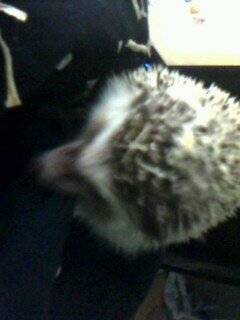
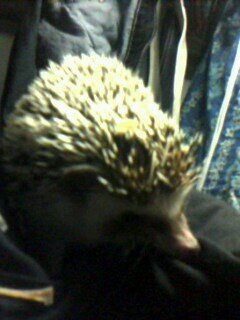
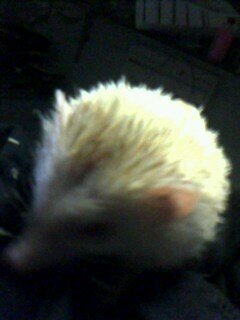
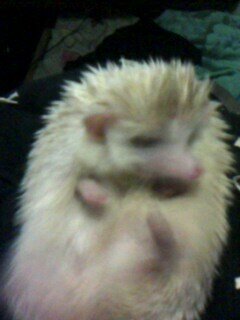
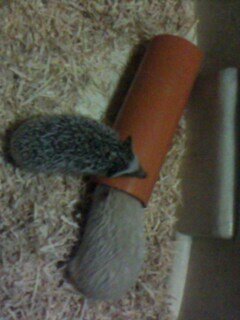
 c sonic b yan?
c sonic b yan?

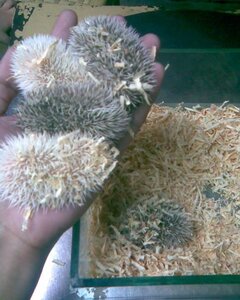
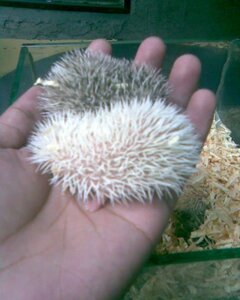
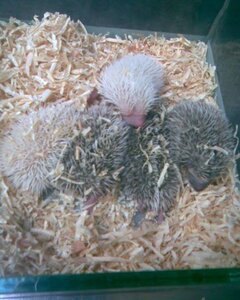
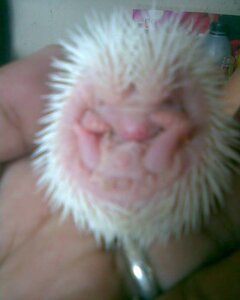
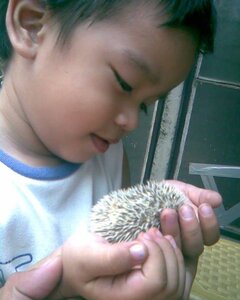
 mag alaga na din kayo hehehe
mag alaga na din kayo hehehe 



